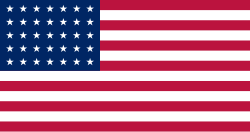
Back الاتحاد (الحرب الأهلية الأمريكية) Arabic Xunión (Guerra de Secesión) AST İttifaq (ABŞ) Azerbaijani Саюз (ЗША) Byelorussian Съюз (Американска гражданска война) Bulgarian Unvaniezh (Brezel diabarzh stadunanat) Breton Unió (Guerra Civil dels Estats Units) Catalan Unie (americká občanská válka) Czech Unionen Danish Nordstaaten German
United States of America | |
|---|---|
| 1861–1865 | |
| Motto: E pluribus unum Out of many, one | |
Anthem:
| |
 | |
| Status | Recognized government of the United States |
| Capital | Washington, D.C. 38°53′N 77°1′W / 38.883°N 77.017°W |
| Largest city | New York City 40°43′N 74°0′W / 40.717°N 74.000°W |
| Government | Federal presidential republic |
| President | |
| Abraham Lincoln | |
• 1865 | Andrew Johnson |
| Speaker of the House | |
• 1861–63 | Galusha A. Grow |
• 1863–65 | Schuyler Colfax |
| Chief Justice | |
• 1861–64 | Roger B. Taney |
• 1864–65 | Salmon P. Chase |
| Legislature | Congress |
| Senate | |
| House of Representatives | |
| Historical era | American Civil War |
| December 20, 1860–May 20, 1861 | |
| April 12–13, 1861 | |
| April 9–November 6, 1865 | |
| Currency | United States dollar |
| Today part of | United States |
The Union was the central government of the United States during the American Civil War. Its civilian and military forces resisted the Confederacy's attempt to secede following the election of Abraham Lincoln as president of the United States. Lincoln's administration asserted the permanency of the federal government and the continuity of the United States Constitution.
Nineteenth-century Americans commonly used the term Union to mean either the federal government of the United States or the unity of the states within the federal constitutional framework. The Union can also refer to the people or territory of the states that remained loyal to the national government during the war.[1] The loyal states are also known as the North, although four southern border states and the future state of West Virginia remained loyal to the Union,[a] and Black Southerners and many Southern Unionists opposed secession and supported the Union war effort.
The Northeast and Midwest provided the industrial resources for a mechanized war, producing large quantities of munitions and supplies and financing the war. They provided soldiers, food, horses, financial support, and training camps. Army hospitals were also set up across the Union. Most Northern states had Republican governors who supported the war effort and suppressed anti-war subversion.[2] The Democratic Party supported the war at the beginning in 1861, but by 1862 it split into the War Democrats and the anti-war element known as Peace Democrats, led by the "Copperheads".[3] The Democrats made major electoral gains in 1862 in state elections, most notably in New York. They lost ground in 1863, especially in Ohio. In 1864, the Republicans and War Democrats joined to campaign under the National Union Party banner, which also attracted most soldiers,[4] and scored a landslide victory for Lincoln and his entire ticket against Democratic candidate George B. McClellan.
The war years were quite prosperous except where serious fighting and guerrilla warfare ravaged the countryside. Almost all military actions took place in the Confederacy. Prosperity was stimulated by heavy government spending and the creation of an entirely new national banking system. The Union states invested a great deal of money and effort in organizing psychological and social support for soldiers' wives, widows, and orphans, and for the soldiers themselves. Most soldiers were volunteers, although after 1862 many volunteered in order to escape the draft and to take advantage of generous cash bounties offered by states and localities. Draft resistance was notable in some larger cities, especially in parts of New York City, with its massive anti-draft riots of July 1863 and in some remote districts such as the Coal Region of Northeastern Pennsylvania.
Cite error: There are <ref group=lower-alpha> tags or {{efn}} templates on this page, but the references will not show without a {{reflist|group=lower-alpha}} template or {{notelist}} template (see the help page).
- ^ "Books and Manuscript Submission Guide". Army University Press. Retrieved April 28, 2021.
- ^ Smith, Michael T.; Engle, Stephen D. (2018). "Review of 'Gathering to Save a Nation: Lincoln and the Union's War Governors', Engle, Stephen D". Louisiana History: The Journal of the Louisiana Historical Association. 59 (3): 361–363. ISSN 0024-6816. JSTOR 26564816.
- ^ Thomas, Benjamin P. (2008). Abraham Lincoln: A Biography. SIU Press. p. 377. ISBN 9780809328871.
- ^ Thomas, Benjamin P. (2008). Abraham Lincoln: A Biography. SIU Press. p. 428. ISBN 9780809328871.
© MMXXIII Rich X Search. We shall prevail. All rights reserved. Rich X Search


